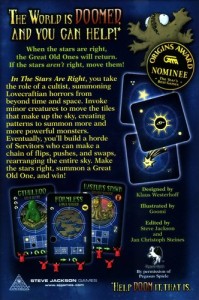This week’s Monday Night Gaming: The Stars are Right. (My apologies for any typos. I broke my wrist last week and dictated this via speech-to-text software.)

Image copyright Steve Jackson Games
# of Expansions: 0
# of Players: 2-4 Players
Best with: 2 Players
Publisher: Steve Jackson Games
Avg. Play Time: 1 hour
Parts: 80 cards & 25 double-sided tiles
Overall Rating: 6/10.
One of the reasons that I like The Stars are Right is because it’s based off of the Lovecraft mythos. Twenty-five double-sided tiles serve as the stars, which need to be right in order to summon creatures & win.
General Mechanics: The night sky is represented by a 5 x 5 grid of double-sided star tiles. Players take turns arranging the stars by flipping, rotating, or swapping tiles, or by pushing rows of tiles to create the correct pattern. Patterns are used to summon powerful creatures such as minions, servitors, or great old ones. What gets summoned determines how a player can move the stars.
Little minions will flip tiles or push an entire row of tiles, while servitors can chain flips, pushes, and swaps.
Because the star tiles are double-sided, there’s a ton of variation in how the stars begin & how the game progresses.
Players can sacrifice a card from their hand and use the powers on it to summon a creature, or they can rearrange the board in order to set up a summoning. Because your opponent can also rearrange the board, they can mess up your ability to summon creatures. This can be quite frustrating.
The idea is to summon creatures before your opponent & gain points. If you manage to summon creatures, your options for rearranging the board increases dramatically. The more cards on the table, the more difficult it can be to summon what you need.
How to Win/Lose: Each creature is worth a certain number of points, and the greater the creature, the more points it’s worth. The first person to reach 10 points wins.
What I Liked: One of the aspects that I like about this game (besides being based on the Lovecraft mythos) is the variation. As far as card strategy games go, this one borders on random with strategy because the starting star tiles are random. You have to try and out think your opponent because every move changes the stars and your options. In fact, the more players you have, the more board changes occur, thus making for a longer game.
What I Didn’t Like: Because of the random element, it can be hard to develop a winning strategy without repetitious play.
Overall Rating/Impression:
It’s a fun, typical Steve Jackson Game. Unlike the rest, this one has a bit more strategy kick to it.
Read the rest of the Monday Night Gaming series by clicking here.

